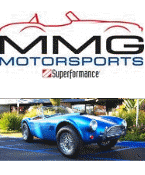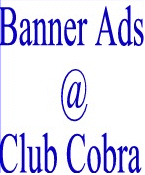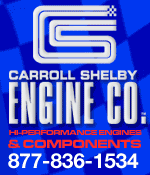 
 Main Menu
Main Menu
|
 Nevada Classics
Nevada Classics
|
 Advertise at CC
Advertise at CC
|
 November 2025
November 2025
|
| S |
M |
T |
W |
T |
F |
S |
| |
|
|
|
|
|
1 |
| 2 |
3 |
4 |
5 |
6 |
7 |
8 |
| 9 |
10 |
11 |
12 |
13 |
14 |
15 |
| 16 |
17 |
18 |
19 |
20 |
21 |
22 |
| 23 |
24 |
25 |
26 |
27 |
28 |
29 |
| 30 |
|
|
|
|
|
|
|
 CC Advertisers
CC Advertisers
|
|

04-23-2004, 01:59 PM
|
|
CC Member

|
|
|
Join Date: Nov 2003
Location: Dacula,
GA
Cobra Make, Engine: Porsche 928 S4
Posts: 408
|
|

 Not Ranked
Not Ranked
 Brake sizing, front/rear ratios
Brake sizing, front/rear ratios
I'm trying to determine the optimum brake caliper piston areas for a road race cobra. Assuming a Cobra has equal brake pressure and volume from the master, equal disks front and rear, is there a basic caliper piston area ratio to strive for? I would have guessed it might be something like rears at 50% piston area of fronts. While using rdorman's great brake spreadsheet, I was surprised to see that the sample has equal piston areas front and rear.
It sure would be nice to hear from rdorman and Richard Huggins on this....
|

04-24-2004, 07:14 AM
|
|
CC Member

|
|
|
Join Date: Apr 2004
Location: pittsburgh,
pa
Cobra Make, Engine:
Posts: 12
|
|

 Not Ranked
Not Ranked
HI MIKE; FROM MY SIDE POINT ( INVOLVED WITH BRAKE MANUFACTURING) SIZE OF ROTOR OR CALIBER IS BASED ON 3-4 FACTORS. 1. TIRE CONTACT AREA 2. TIRE SIZE( ROTATING MASS)3. PRODUCTION MATERIAL OF ROTOR 4. EFFECTIVE PISTON PRESSURES OF THE CALAPER. IF YOU RUNNING SAY BAER ROTORS THER PUBLISHED BRAKEING DISTANCE ARE NOT THE MUCH BETTER THAN STOCK DISTANCES. WILWOOD HAS THE SAME PROBLEM BUT THE HAVE PISTON DRAG FOR HEAT DISTORTION. RED DEVIL BRAKES HAVE ABOUT 60% BETTER STOPPING DISTANCE WITH THEIR COATED ROTORS & PADS ALONE WITH STOCK CALIPERS. THE DIAMETERS ARE SMALLER AND LESS ROTATING MASS. I HAVE RED DEVIL ROTORS & PADS AND HAVE STOPPING DISTANCES OF 60-0 OF 88 FEET WITH STOCK CALIPERS AND MY CAR WEIGHT IS 4068 LBS. WITH A 2900 LB CAR I HAVE STOPPING DISTANCE OF 60-0 AT 69-72 FT SAME ARRANGEMENT OF CALIPERS. AFTER THE BRAKES GET HOT THE STOP EVEN BETTER, AND I HAVE NEVER HAD ANY WARP FROM HEAT. CHECK THE OUT ON THE WEB .. WWW.REDDEVILBRAKES.COM |

04-24-2004, 07:50 AM
|
|
CC Member

|
|
|
Join Date: Dec 2003
Location: Gurnee,
IL
Cobra Make, Engine: Kirkham #259
Posts: 1,396
|
|

 Not Ranked
Not Ranked
Mike
I'm not the R's.... but go to this site and read and then click on the computer spread sheet and you will answer all of your questions...
It's a article published by Circle Track mag and is perfect and the spread sheet allows you to fill in the variables and change sizes of things and it computes the front to rear Ratio's....
If you have any questions let me know ...it's good to know what you are doing before you do it...
http://dsr.racer.net/brake_bias.htm
Morris
__________________
Morris
|

04-24-2004, 09:33 AM
|
|
CC Member

|
|
|
Join Date: Nov 2003
Location: Dacula,
GA
Cobra Make, Engine: Porsche 928 S4
Posts: 408
|
|

 Not Ranked
Not Ranked

Thanks Morris, Rick Dorman put together a braking spreadsheet and it was discussed here some time ago. It's really slick and takes into account just about everything, stuff like tire traction and cg height. In order to use the spreadsheets I need to know what I'm after for F/R ratios.
Just some random thoughts: I would guess that in order to prevent the rear brakes from locking up going into a turn under heavy braking they would have to have a very small percentage of total braking, not merely 5-10% less.
Wouldn't it be nice if the rear brakes had proportionally less pressure as the total pedal force and presumebly the front weight bias increased? How could this be accomplished?
Dennis Olthoff made a good point about the effect of engine deceleration on rear brakes.
Here's what I'm planning for my own car:
13" front rotors with Wilwood 6 piston calipers, total piston area=4.03 sq.in.
Now, what to use for the rears? I was thinking of a 4 small pistons of about 1/2 the total area of the fronts on a 10.5 disk. That's where I'm at now.

|

04-25-2004, 08:01 AM
|
|
CC Member

|
|
|
Join Date: Dec 2003
Location: Gurnee,
IL
Cobra Make, Engine: Kirkham #259
Posts: 1,396
|
|

 Not Ranked
Not Ranked

Mike
If you go to the webb site I gave you and look down at the bottom of the page .... it will say "computer worksheet or spread sheet.... click on that work sheet an it will give you the ability to make variable changes like you just said....
And it makes it easy to change puck sizes to not only figure out the area of the braking surface...but how much clamping pressure it will have verses the front clamping pressure...as well as the ratio of the front to rear percentages.... and the amount of pedal movement as the pad wears down....
The optimium setting is going to be between 65-70 % on the front....
As far as your Fronts go.... 6 piston calipers are going to have in the area of 8.0 square inches (2ea 1.62 pistons and 4 1.12"pistons).....
Rears will have about half of that .... 4 sq inches.... (4ea 1.25" pistons)....ball park numbers....
Rear Rotor should be 11.75 or better .... Front as big as you can get....13" is a good size...
Then use the master cyl to balance ......and pad to finish balanceing based on the track....
Morris
__________________
Morris
|

04-26-2004, 07:40 AM
|
 |
Renegade Nuns on Wheels

|
|
|
Join Date: Aug 2001
Location: columbus,
Oh
Cobra Make, Engine: Unique 427 roadster with 351C-4B
Posts: 5,129
|
|

 Not Ranked
Not Ranked

Some general thoughts. Start with desired pedal pressure. You will want to keep it under 75 pounds or so otherwise it just can be to much work! Pick your pieces so that are balanced for maximum deceleration by design. That is the balance bar will be centered and the master cylinders are within a size or two from each other. Having the master cylinder close in size will mean that you will have close amounts of travel and less risk of the balance bar binding. Of course you have to balance the components at the wheel to accomidate this. Keep line pressures under the manufacturers recommendations or 1000psi which ever is less.
Rotor size. You can easily calculate the heat generated by stop. Pick a good average speed stop, say 120-50 or something like that, and multiply that temperature rise by 10 and buy rotors with enough mass to accomidate that temperature rise. Pick your pads by this temp as well. A typical weight Cobra a 12.19" iron front rotor is usually sufficient for all but endurance racing. Use a cast iron ventilated rotor, slotted NOT cross drilled. There have been some really good improvement in the vane design over the old straight vanes that do have numerious advantages.
Now that you have picked you pedals (pretty much dictated by packaging and personal preference, I prefer them to pivot from the floor......... you will to!), rotors, pad compound and you know the maximum brake torque required (from the spreadsheet), balance your hydraulic components. Play with the different caliper and master cylinder sizes available to get the proper balance. Be careful not to get to small of a master cylinder compared to the caliper size.
Order your stuff, carefully install and test. If you have a G meter that can be handy or you can use toppling blocks. Get the balance right and use temp paint to verify the system operating temperatures. Use pad compound, bias and ducting as tuning tools. Change your fluid before every event. There should be no need for exotic fluids in this application. Good fluid like some of the OEM stuff designed for high temp or something like Wilwood 570 or valvoline synthetic should suffice.
HERE IS ONE TRUTH IN BRAKES: There are NO miracle brakes when it comes to stopping distance. If a car can lock all four wheels, then there is sufficient brake torque available to stop the car at maxiumum deceleration. Tuning bias may help a bit (particuarlly OEM systems). Adding bigger brakes and changing nothing else WILL NOT SHORTEN THE STOPPING DISTANCE by any significant amount. There could be slight gains through pad compound (better initial bite), and tolerence/quality (less run out, better seal design etc) but that is it. In fact, you could end with a car that does not brake as well as the OEM system. If properly engineered, what you will end up with is a braking system that at the very least will give small reductions in stopping distance and will vastly improve fade resistance. YOU CAN NOT TAKE A CAR THAT CAN LOCK ALL FOUR AND CUT STOPPING DISTANCE BY 60% SIMPLY BY CHANGING BRAKE COMPONENTS.
By the way, I checked out the spread sheet in the dsr racer link. It leaves out or assumes a great number variables (it states so at the top). VERY IMPORTANT variables. I would not recommend using it to design a system from scratch. Even my spread sheet needs a little thought, common sense and some other factors considered and it includes all the factors that the dsr one does not.
Happy braking!
Rick
Last edited by rdorman; 04-26-2004 at 07:45 AM..
|

04-26-2004, 11:05 AM
|
|
CC Member

|
|
|
Join Date: Jan 2000
Location: scottsdale,az,
Posts: 733
|
|

 Not Ranked
Not Ranked
One of the things that I just learned is the amount of weight transfer that takes place in a cobra. The weight transfer if a function of a short wheel base, cg heigth, and traction. With street tires, you should run more rear bias then you would with slicks. With slicks, more weight transfers so you need a lot more front brake bias. My hi-tech static weight balance is 51% rear, 49% front. Under threshhold brkeing with slicks, the front is in the 72 to 74% range, the rear is 26 to 28%. Godd luck, scott
|

04-26-2004, 11:35 AM
|
 |
Renegade Nuns on Wheels

|
|
|
Join Date: Aug 2001
Location: columbus,
Oh
Cobra Make, Engine: Unique 427 roadster with 351C-4B
Posts: 5,129
|
|

 Not Ranked
Not Ranked

Quote:
Originally posted by coyled
One of the things that I just learned is the amount of weight transfer that takes place in a cobra. The weight transfer if a function of a short wheel base, cg heigth, and traction. With street tires, you should run more rear bias then you would with slicks. With slicks, more weight transfers so you need a lot more front brake bias. My hi-tech static weight balance is 51% rear, 49% front. Under threshhold brkeing with slicks, the front is in the 72 to 74% range, the rear is 26 to 28%. Godd luck, scott
|
Bingo!
The formula from my spread sheet for vertical force on both front tire (directly related to maximum braking and balance) is:
weight * ( 1- ( distance from front axel center line to center of gravity / wheelbase ) + tire coeficient of friction * center of gravity height / wheelbase )) + aerodynamic down force * ( 1 - ( distance from front axle to center of pressure / wheel base ) + ( tire coeficient of friction x center of gravity height / wheelbase ))
From there you can take figure the rear:
total weight + aerodynamic downforce - front verticle force.
In the example I was looking at the front brake torque was 10665 fl-lbs and the rear was 4919 for a 1 G stop or a front to rear ratio of 68/32. Up that to a 1.5 G stop and you get 72/28 and a .5 G stop (ever driven in the rain on slicks? if so you know what I am talking about!) 59/41. Begining to see why no one system will be at its best under all circumstances? See why street cars use proportioning valves and not bias bars? Here is something interesting, what you don't see is that total amount of brake torque is basically the same for a 1.5 G stop as it is for a .5 G stop. Think on that one for a while!
Rick |

04-26-2004, 11:43 AM
|
|
CC Member

|
|
|
Join Date: Dec 2003
Location: Gurnee,
IL
Cobra Make, Engine: Kirkham #259
Posts: 1,396
|
|

 Not Ranked
Not Ranked
There's theory ..... and then Experience....
It aways amazed me how the Theory was always chasing the Experience
__________________
Morris
|

04-26-2004, 01:12 PM
|
 |
Renegade Nuns on Wheels

|
|
|
Join Date: Aug 2001
Location: columbus,
Oh
Cobra Make, Engine: Unique 427 roadster with 351C-4B
Posts: 5,129
|
|

 Not Ranked
Not Ranked
It is a definite plus to have both!
Rick
|

04-27-2004, 07:57 AM
|
|
CC Member

|
|
|
Join Date: Jan 2000
Location: scottsdale,az,
Posts: 733
|
|

 Not Ranked
Not Ranked
Rick, you are right on the money. That 59/41 is about right where I was at with street tires, bfg's. Fronts would lock first. On the track at road america, my back brakes were smoking and I thought I needed more rear brake. As it turns out, I needed way more front bias with slicks. I am at 70% front now. Scott
|

04-27-2004, 09:34 AM
|
 |
Renegade Nuns on Wheels

|
|
|
Join Date: Aug 2001
Location: columbus,
Oh
Cobra Make, Engine: Unique 427 roadster with 351C-4B
Posts: 5,129
|
|

 Not Ranked
Not Ranked
Don't you just love Road America? Only been there a few times but it was a good track. Favorite turn though is the one at Road Atlanta. Forget the turn number but it is the down hill off the back straight before the pit entrance. YEEEEEEEEEEHAAA.
Rick
|
 Posting Rules
Posting Rules
|
You may not post new threads
You may not post replies
You may not post attachments
You may not edit your posts
HTML code is On
|
|
|
All times are GMT -7. The time now is 04:14 PM.
|
















 Hybrid Mode
Hybrid Mode


